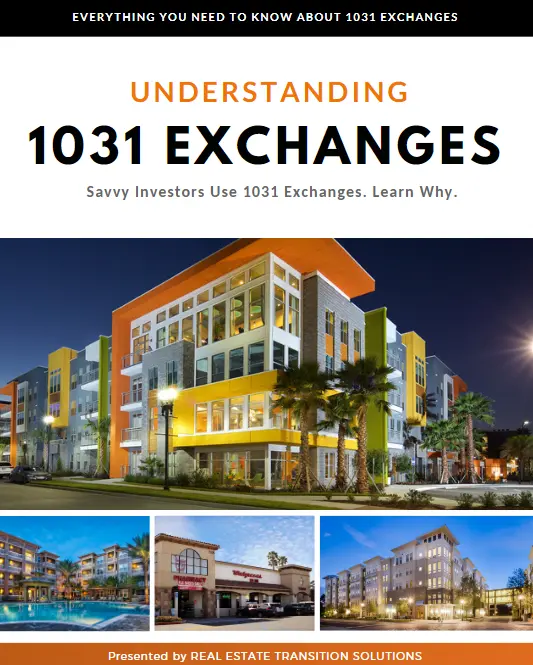Glossary of Terms
1031 Exchange Explained
Key Industry Terms & Concepts
IRC 1031 Exchange
A 1031 Exchange is a transaction approved by the IRS through Internal Revenue Code section 1031 which allows an owner of investment real estate to sell a property (relinquished property) and acquired new property (replacement property) while deferring capital gains tax, depreciation recapture tax, and net investment income tax (if applicable) on the sale of the relinquished property.
Delaware Statutory Trust (DST)
A Delaware Statutory Trust is a legal entity designed to hold institutional investment real estate that is actively managed by professional real estate firms. DSTs allow individual investors to perform a tax-deferred 1031 Exchange into a “beneficial interest” of the trust, also referred to as a “fractional interest” in a larger property or portfolio of multiple properties.
Capital Gains Tax
The tax liability assessed at the Federal level for any increase in investment value. The tax liability comes due upon the sale of an asset unless asset is real estate and is exchanged. This tax rate ranges from 15-20%.
Tax Liability
Tax liability refers to the total aggregate tax bill associated with the sale of a property. The liability can be comprised of Federal Capital Gains, State Capital Gains, Depreciation Recapture and Net Investment Income Tax.
Fractional Interest
Also referred to as a “beneficial interest” is an undivided percentage ownership in a larger property (often high-grade institutional property).
Relinquished Property
The property or properties to be sold in which the sales proceeds and associated tax liabilities are to be exchanged.
Delaware Statutory Trust (DST) Sponsor
DST sponsors acquire the trust’s real estate and manage the property throughout the life of the trust. Management activities include structuring the DST, securing long-term financing, overseeing property management, analyzing and approving capital expenditures, financial and tax reporting, monitoring market conditions and ultimately selling the property.
Replacement Property
The property or properties acquired through an exchange in which the deferred tax liability is rolled into.
Like-Kind Property
The IRS’ requirement that for a property to qualify for an exchange, both the relinquished (sold) and replacement (purchased) property must be held for investment or business purposes.
Equal or Greater Value
The IRS requirement that if an exchange is to have complete tax deferral, the replacement property or properties must have equal or greater value than the relinquished property or properties.
The 45-Day Exchange Identification Rule
Internal Revenue Code section 1031 outlines the timeline a valid exchange must adhere to. Following the sale of the relinquished property, the seller performing an exchange must specifically identify their replacement properties in accordance with the Property Identification Rules. The identification must be submitted to the Qualified Intermediary no later than calendar Day 45 following the sale of the relinquished property.
The 180-Day Exchange Period Rule
Following the sale of the relinquished property, the seller performing an exchange must acquire any/all replacement properties within 180 days. Note the “closing period” continues 135 days beyond the end of the “identification period”.
Accredited Investor
As defined by the SEC, an accredited investor is an individual who has either a $1 million net worth excluding their primary residence or $200,000 of income individually or $300,000 joint income for each of the last two years with a reasonable expectation for the same in the current year.
1031 Exchange Debt Matching
In order to have complete tax deferral, the replacement property or properties must, in aggregate, have a total value either equal or greater to that of the relinquished property. All equity resulting from the sale must be exchanged. Additionally, all debt must be match either by new debt or a contribution of cash from outside the sale.
Qualified Intermediary
The entity that serves as “exchange escrow” and holds on to the exchange proceeds until the replacement properties have been identified and funds are released to purchase them.
Depreciation Recapture
The tax liability assessed at the Federal level for any calculated depreciation on investment property, whether the owner benefited from the depreciation or not. This tax rate is applied at a flat 25%.
Step-up in Basis
The concept that the tax liability associated with an appreciated and/or depreciated property is eliminated, either in part or in full, upon the death of the owner.
Taxable Boot
Taxable boot is the term used for any unused exchange proceeds, whether cash sales proceeds or unmatched debt, that will be considered taxable by the IRS. Taxable boot can be very costly as the IRS will first apply the most expensive Federal tax rate (generally depreciation recapture at 25%) to taxable boot.
Passive Management
Passive management is considered a benefit of investing in Delaware Statutory Trusts as it allows for investors to own investment real estate without the responsibility of managing the property (ownership of DSTs is entirely management free).
High-Grade Institutional Property
High-grade institutional property refers to property that attracts large sophisticated investors due to the size and quality of the property – e.g. pension funds, life insurance companies, real estate investment trusts (“REITs”), university endowments, sovereign wealth funds, etc.
Property Identification Rules
Internal Revenue Code section 1031 outlines three rules for identifying replacement properties, one of which must be adhered to by the exchanger. The three rules are the: three property rule, 200% rule, and the 95% rule.
Three Property Rule
One of the three property identification rules, this rule states that an exchanger may identify up to three replacement properties, regardless of the value associated with the identified properties.
The 95% Rule
One of the three property identification rules, this rule states that an exchanger may identify any number of replacement properties with no limits on the aggregate value of the properties, so long as 95% of the aggregate value of the identified property is closed on.
The 200% Rule
One of the three property identification rules, this rule states that an exchanger may identify any number of replacement properties, so long as the aggregate value of the identified replacement properties does not exceed 200% of the value of the relinquished property.
Constructive Receipt
The concept that the IRS will not allow an exchange to occur if the seller had the ability to direct the sales proceeds following the close of the sale – hence the need for the Qualified Intermediary.
Net Investment Income Tax (NIIT)
A relatively new tax created in 2013 as part of the Health Care and Education Reconciliation Act, Net Investment Income Tax (NIIT) is a 3.8% tax assessed on all investment income (including the sale of investment property) over a certain threshold.
Low Cost Non-Recourse Debt
DST sponsors are large institutions with access to low cost debt at interest rates that are generally well below those available to individual investors. All debt used for DSTs is required by IRS Revenue Ruling 2004-86 to be non-recourse for the investors, reducing investor risk and exposure.
Download These FREE Guides to Learn More About 1031 Exchanges
Download our FREE guides to learn more about 1031 Exchanges, how they work, and 1031 Exchange rules. And don’t forget to check out our 1031 BLOG to stay on top of different 1031 Exchange strategies and investor tips.

Understanding
1031 Exchanges
- 1031 exchange basics
- How 1031 exchanges works
- Benefits vs. risks
- 1031 exchange rules
- 1031 exchange options

Investing in
Delaware Statutory Trusts
- What is a Delaware Statutory Trust
- How DSTs works
- Benefits vs. risks
- 1031 exchange rules for DSTs
- 1031 exchange options for DSTs

